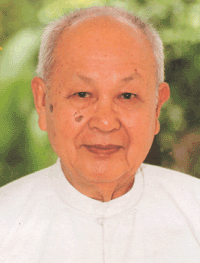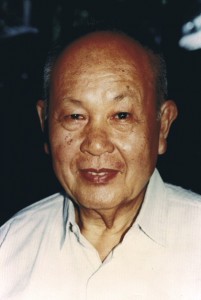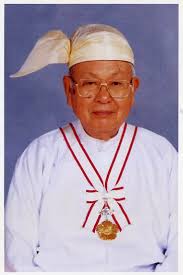Dr. Than Tun Collection
Brief Biography
Dr. Than Tun was born in 1923 in Ngathaingchaung town, Yeikyi township, Ayeyawady Division. He obtained his M.A degree in 1950, B.L degree in 1952 both from University of Rangoon. From 1952 to 1956 he studied in London University, Schools of Oriental and African Studies for the Ph. D degree and Submitted the thesis “Buddhist in Pagan Period”. He was awarded the Ph. D degree in 1956. In 1959 he became a lecturer in Rangoon University, Dept. of History and Political Science.
In 1965 he was promoted to the Professor and Head of Dept. in History at Mandalay University, and he worked in Mandalay for nearly 20 years. He left Mandalay form 15 Aug 1982. In 1982 he went to Tokyo University, Dept of South East Asian Studies. Dr. Than Tun retired in 1983, while he was in Japan.
From 1982 to 1987 he worked as a Research Fellow and Visiting professor in Tokyo University of Foreign Studies, Dept of African and Asian Languages and Cultural Studies, Tokyo International Christian University and Osaka University at Foreign Studies.
Later from Japan he went to USA and worked as a visiting professor in Northern Illinois University awarded Dr.Than Tun an Honorary Doctor of Literature in 1988. During the years that he was in Japan and USA . He compiled and published the “Royal orders of Burma” in 10 vols. In 1990 he came back to Myanmar and is at present working as a Member of the Myanmar Historical Commission and Emeritus Professor in Yangon University in the Dept. of History and Dept. of Archaeology.
In 2000 Fukuoka Asian Culture prize Committee awarded Dr. Than Tun the highest world-wide academic award, a Literate of the 11th Fukuoka Asian Culture Prizes 2000 in the Academic Prize Category. One of Asia’s leading historians, Dr. Than Tun offered a new interpretation of Myanmar history that criticized the prevailing trends in pre-modern history studies, which had been predominantly engaged in the glorification of dynasties. His new interpretation constructed a strict, demonstrative methodology of history. His academic achievements have greatly contributed to the development of the studies of Myanmar history and to the recognition of Myanmar’s history and culture in the world history context.
On 30 November 2005, Dr. Than Tun died unexpectedly while traveling to a 90th birthday celebration in Mandalay for celebrated Burmese literary figure Ludu Daw Amar. The professor was buried in a cemetery on the outskirts of Amarapura, south of Mandalay, where some 300 people, many of them former students, gathered to mourn his death. He was survived by his wife Khin Yi, and daughter, Mizu Than Tun.
Collection
1. Bagan Restoration (Pub. Dec 1976)
This paper was originally written in Myanmar and read at the Saturday Literary Circle meeting held at the Po Wa Ziya Hall of the Hanthawady Press, Mandalay on 20th Sep, 1975. It was later read in English to the special meeting of the Burma Research Society on 15th October, 1975. Normally Bagan monuments are Ceti style with a solid structure or
Ku, which were places of worship where people could enter the building to offer homage. In addition, there was also a House of the Law and House of the Monks of the Order. Many Bagan inscriptions record the donors as well as those who repaired the monuments. Some repairs were were necessary but others destroyed the original edifice. The author
suggests three points for restoration of Bagan monuments:
(1) Use no heavy materials on the top of time weakened brick supports.
(2) Match the body with the correct finial and
(3) Permit no mis-fit of materials or appearances
Pagan-Restoration
2. Administration during King Thalun (Pub. June , 1966)
3. Administration under King Thalun (1629-48) (Pub. Dec. 1968)
King Thalun (AD 1629 – 48) was a successful ruler of Toungoo Dynasty (AD 1486 – 1752). He was seriously concerned with the welfare of his people. Buddhism also prospered during his reign and he was noted for his peaceful governance and the improved living conditions throughout his realm.
Administration-under-King-Thalun-1629-48
4. History of Burma, A.D. 1300-1400 (Pub. Dec 1959)
The author chronicles the kings and rulers of later Bagan and explains and how they described the Myinsaing, Sagaing and Pinya dynasties. The many references used for this article are all drawn from the inscriptions. This period is described as the most troubled in the Myanmar history. Nonetheless, forest dwellers (monks) and the kings of the later period laid the foundation for the political and cultural progress Myanmar made in the 15th and 16th centuries.
History-of-Burma-AD-1300-1400
5. Mahakassapa Sect. (A forest monk sect at Pagan) (Pub. 1959)
Mahakassapa-Sact.-A-forest-monk-sect-at-Pagan
6. Religious buildings of Burma, A.D. 1000-1300 (Pub. Dec 1959)
This paper was read at the Annual Research Conference of the Burma Research Society on 24 December 1959. It describes religious architecture between AD 1000 and 1300: the construction plans of pagodas both solid and hollow, monasteries of brick and wood, and others religious edifices including alms houses, rest-houses, libraries, and reservoirs which contributed to propagation of the Buddhist Sasana.
Religious-Buildings-of-Burma-AD-1000-13000
7. Religion in Burma , A.D. 1000-1300 (Pub. Dec 1959)
This paper was read at the Kanthaseinlai Group meeting on 13th July 1958. It argues that the Myanmar (Burmans) were Buddhist long before King Anawrahta’s (Aniruddha) conquest of lower Burma. They did not practise Theravada Buddhism, rather they observed a form of Mahayana Buddhism much influenced by Vaishnavism and native Naga (serpent) worship. With the conquest of Thaton in 1057 AD by King Anawrahta Theravada Buddhism was introduced to Central Burma. According to the excavation of Srikshetra and Hanlin the Pyu already believed in Buddhism. This paper is based on Bagan inscriptions which reveal the spread of Buddhism between AD 1000 – 1300.
Religion-in-Burma-AD-1000-1300
8. Social life in Burma, A.D. 1044-1287
Analyzes social life and customs of the Bagan people during the period AD 1044 – 1287. The vocations of the Bagan people were: agriculture, including cowherds; food suppliers; craftsmen; musicians; and such diverse work as midwifery, laundress, boatmen, palanquin carriers, oil producers, water carriers and canal diggers. The slaves (kywan) in those days was different from later periods as individuals voluntarily turned themselves into slaves of religious establishments. A pagoda slave did not sink in the social scale, rather he gained merit and respect from his family and community.
Social-life-in-Burma-AD-1044-1287
9. An estimation of articles on Burmese history published in the J.B.R.S. 1910-70 (Pub 1970)
An-estimation-of-articles-on-Burmese-history
10. Mahakassapa and his tradition (Pub. 1959)




